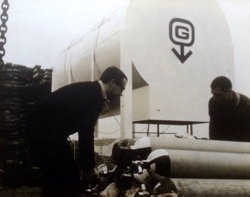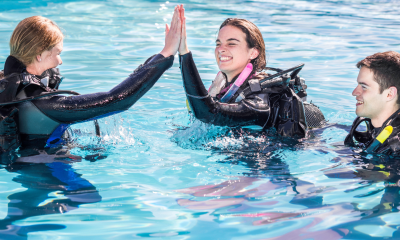News
Extraordinary underwater living project re-visited

Bournemouth and Poole Sub Aqua Club in the UK celebrated their 60th anniversary by recounting the inspirational story of a former member who made history by living underwater for an entire week.
Back in September 1965, Colin Irwin, who was then aged 19 and science officer for the club, spent seven days on the seabed of Plymouth Sound in a specially made steel cylinder to investigate long-term survival in an underwater habitat.
The Glaucus Project – named after a Greek sea god – was a tremendous success and still has its place in the Guinness Book of Records.
Colin gave a gripping account of his adventure to members of the club when they gathered to mark its 60th anniversary at a special event in the Harbour View Suite of the RNLI College in Poole on Saturday 29th March.
Inspired by similar experiments carried out in the early 1960s by legendary French diver Jacques Cousteau, he decided to set up a project to put an undersea habitat in place and occupy it for a week along with fellow club member John Heath, then 21.
Adrian King, who has been a member of the club since 1976 and served as its chairman for the past six years, said: “Even by modern standards this was a hugely ambitious project which at the time – and indeed since – had only been attempted by a few majorly funded operations such as Jacques Cousteau and the likes of the America Sea Lab.
“A sub-committee was formed to raise the £1,000 needed to finance the project. The father of one of the members owned a local boatyard and they built the steel cylinder for the project from scratch. Weighing two tons, it was 3 .7 metres long and 2.1 metres in diameter, standing on legs and ballasted by weight in a tray beneath it.
“Entry was made via a tube on the underside which was open to the water. Pressure inside would therefore be the same as the surrounding water, resulting in the divers being at pressure for the duration of the project.
“The main cylinder was equipped with two compartments, a main living area and a separate toilet compartment.
“The two young men kept in touch with the surface via an old ex-army wind up telephone and there was also a small CCTV camera to allow the condition of the crew to be monitored constantly from above.
“The cylinder was towed into place by a tug then lowered 35 feet or 11 metres to the seabed near the Breakwater Fort and marked by a buoy on the surface.”
Adrian added: “Where this one differed significantly from the Cousteau and American experiments was that the Glaucus Project cylinder was not linked to the surface by an airline but had its own artificially maintained air environment with a chemical `scrubber’ to remove the carbon dioxide.
“It was for this reason and the length of time the two men spent underwater that Glaucus still has a place in the Guinness Book of Records.
“The cylinder was far from comfortable to be in with the temperature being about 16 degrees. In addition the near 100% humidity caused by the open entrance meant that condensation was colossal and keeping anything dry became almost impossible. Food and drinks were sent down to them in army field pressure cookers.
“Despite these difficult conditions Colin and John continued with the project and even ventured from the cylinder into the surrounding waters to conduct a number of surveys aimed at proving the ability of divers to both live and work at depth.”
At the end of seven days, attempts to slowly bring the cylinder to the surface were abandoned due to buoyancy problems and the two crew members eventually made their way to the surface wearing scuba gear.
Colin Irwin, who now lives in the Liverpool area, has enjoyed a varied life of adventure including working for National Geographic magazine and sailing on a yacht through the North West Passage of Canada.
Now aged 68, he is a Research Fellow in the Department of Politics at the University of Liverpool and in the Institute of Governance at Queen’s University Belfast.
Colin said: “Although it was nearly 50 years ago I still clearly remember the time John and I spent down in the cylinder. In fact, I still have the daily log for the project.
“We had heard about the Cousteau experiments and didn’t want it to be something that was just done by the French, so we thought we would do our own experiment.
“What I recall most about our time in the cylinder is that it was very cold and damp. However, we did have our food sent down in an army thermos.
“After we had been down there for a couple of days a really ferocious gale blew up on the surface but luckily it didn’t affect us too much and the project was able to continue.
“John and I did some experiments in artificial atmosphere while we were down there. We raised the oxygen level to a point where we wouldn’t get the `bends’ when we came up and I think this must have worked because we didn’t get them.”
The Glaucus cylinder is still underwater not far from its original site. It is dived regularly and the club now has a project to fix a plaque to the structure marking the achievement of 49 years ago.
To find out more about the Bournemouth and Poole SAC, click here.
Source: www.bsac.com
News
Book Review: Fire on Monroe Bravo by Fred Lockwood

Fire on Monroe Bravo is the latest book in the Jack Collier series by Fred Lockwood. Our story begins with our lead characters, Jack and Sandro, owners of Marine Salvage & Investigation Company, arriving on the Monroe Bravo Oil & Gas Platform in the North Sea. Having secured a contract for their vessel the MV Stavanger to act as support ship to the platform for TransGlobal Oil, our protagonists are on a celebratory visit.
However almost as soon as they arrive a series of explosions rock the platform, causing huge damage, loss of life and the very real danger of a massive human, ecological and financial disaster.

As the danger mounts for both our heroes and the surviving workers, Jack and Sandro will have to escape the inferno, all while trying to save the platform and the men still trapped unable to help themselves.
The disaster sets the scene for the unfolding story lines following the fate of the platform and our main characters, the police investigation into a suspected terrorist act and the actions of TransGlobal Oil as they attempt to navigate the pubic outcry and financial repercussions.
In his eighth book, Fire on Monroe Bravo, Fred Lockwood delivers an explosive thriller, with plenty of above and in-water drama, and our heroes fighting for survival, what more can you ask for?
We thoroughly recommend this read and look forward to the next in the series. For more information about his book series, you can check out the reviews of his previous books here on Scubaverse.
- Title: Fire On Monroe Bravo
- Author: Fred Lockwood
- ISBN: 979-8325324536
Available in a paperback version and for Kindle from Amazon and book stores.
Blogs
Alonissos: The complete diving destination (Part 1)

In June we were incredibly fortunate to be invited to dive in Alonissos, a small Greek Island in the Sporades island chain located in the North Aegean Sea. While I have long been a big fan of the Greek Islands as a great holiday destination, I had not had the opportunity to do any diving on previous visits and Mike and I were extremely excited to see what Alonissos had to offer both above and below the surface!

The Sporades are easily accessible via the airport in Skiathos (the first island in the chain), which is served by Jet2 flights from all major UK airports from May through October. Numerous ferries and charter boats make island hopping from Skiathos Town a breeze. After an hour boat ride, the picturesque port of Patitiri was a wonderful introduction to Alonissos, where we were met by our gracious hosts Kostas of Albedo Travel and Dias of Alonissos Triton Dive Center. Mike and I were delighted to be staying at the Paradise Hotel, aptly named for its stunning views over the sea and great location for walking to the waterfront.

Alonissos is beautifully situated in the National Marine Park of Alonissos and the Northern Sporades, the largest marine protected area in Europe. The surrounding seas offer fabulous marine life, including incredibly rare species such as the Mediterranean monk seal. They boast deep walls covered in gorgonians and sponges, stunning topography with caverns, swimthroughs and pinnacles, and the first accessible ancient shipwreck from 500BC!

In locations where historical sites have been reported, the waters are largely restricted, but with collaboration between government, underwater archeologists and dive centres, incredible underwater museums are being created for a truly unique diving experience. Alonissos is home to the first of these, the Ancient Shipwreck of Peristera Accessible Underwater Archeological Site. The chance to dive into history (along with reports of healthy reef life and amazing underwater topography) meant Mike and I were keen to get in the water.

Our introduction to the diving around Alonissos was at the Agios Georgios Pinnacles, in the channel between Alonissos and Skopelos. This fantastic site was named “The Chimney,’ and proved to have a huge amount to see. We got to a decent depth here (over 25m), and marvelled at a colourful reef wall with a wonderful swim through whose rocky walls were absolutely covered with life. As well as brilliant topography there was no shortage of macro life here. We saw numerous nudibranchs, five different species in total. The second dive at Mourtias reef nearby was a shallower dive along a nice wall with lots of crevices. Several moray eels and grouper called this site home. We enjoyed looking in the crevices for lobster and smaller benthic life, such as cup corals and tunicates.

Our itinerary allowed us two dives a day with afternoons left to explore the island with our hire car and evenings to enjoy the famous Greek hospitality. This proved to be a lovely mix of in-water and land based diversions.

The next days diving to the Gorgonian Gardens and Triton’s Cave was to be even better! These two stunning sites are nothing short of fabulous. The Gorgonian Gardens was a deep wall near to the Agios Georgios islands. The ever-present currents in this deep channel meant that the sea life was amazing … the namesake Gorgonian sea fans dotted the wall at a depth of 30 to 50 meters, getting ever larger the deeper we went. Above 30m was by no means less beautiful, with sponges, corals, scorpionfish, moray eels and some rare and colourful nudibranchs.

The second shallower dive of the day was to Triton’s Cave or the Cavern of Skopelos, on the east side of that island. The spectacular rock formations had wild striations both above and below the water making a truly epic topography. The cavern entrance was at 14m, and big enough for a buddy pair, winding up to 6m and passing two beautiful windows out into the blue. Emerging from the cavern, the light at the shallower depths and the incredible rock formations made for a fantastic gentle swimming safety stop and we all surfaced by the boat with massive grins.

Check out our next blog :Alonissos: The complete diving destination (Part 2)” to hear about our amazing dive on the 2500 year old Peristera Wreck!
Thanks to:
Alonissos Triton Dive Center https://bestdivingingreece.com/
Albedo Travel https://alonissosholidays.com/activities/
Paradise Hotel https://paradise-hotel.gr/
Alonissos Municipality https://alonissos.gr/en/
-

 Blogs2 months ago
Blogs2 months agoDiving With… Nico, Ocean Earth Travels, Indonesia
-

 News1 month ago
News1 month agoMurex Bangka Announce New Oceanfront Cottages & Beachfront Dining
-

 Blogs2 months ago
Blogs2 months agoA new idea in freediving from RAID
-

 Marine Life & Conservation1 month ago
Marine Life & Conservation1 month agoIceland issue millionaire whale hunter a licence to murder 128 vulnerable fin whales
-

 Marine Life & Conservation2 months ago
Marine Life & Conservation2 months agoThe Shark Trust Great Shark Snapshot is back
-

 News3 months ago
News3 months agoCharting New Waters; NovoScuba Goes Global with the Launch of their Revolutionary Dive Training Agency!
-

 Gear News1 month ago
Gear News1 month agoNew Suunto Ocean – a dive computer and GPS sports watch in one for adventures below and above the surface
-

 Marine Life & Conservation Blogs2 months ago
Marine Life & Conservation Blogs2 months agoBook Review: Plankton















